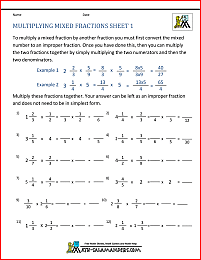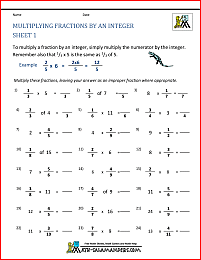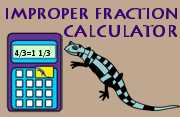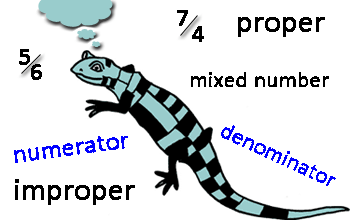- Home |
- About |
- Contact Us |
- Privacy |
- Newsletter |
- Shop |
- Donate
How to Multiply Mixed Fractions
Support Page

Welcome to our How to Multiply Mixed Fractions support page.
This page will support you in learning how to multiply two mixed fractions together, and show you some worked examples.
How to Multiply Mixed Fractions
Multiply Fractions Calculator
We have a calculator to help you to multiply fractions.
You can use the calculator for multiplying improper fractions or mixed numbers too.
All the working out is shown step-by-step so you can see how it is worked out.
How to Multiply Mixed Fractions Information
Before your child tackles multiplying fractions, they should be confident with:
How to Multiply Mixed Fractions Support
Frazer says "To multiply two mixed fractions, follow these simple steps."

Step 1)
- Convert any mixed numbers into improper fractions;
- Put any integers over a denominator of 1.
Step 2)
Multiply the numerators and denominators of the two fractions together. This will give you the answer.
Step 3
Simplify the answer and convert your answer back into a mixed number if needed.
And that's how to multiply mixed fractions!
Examples of How to Multiply Mixed Fractions
Example 1) Calculate \[2 {3 \over 5} \times 1 {2 \over 3} \]
Step 1) Convert the mixed numbers into improper fractions
\[2 {3 \over 5} = {13 \over 5} \] and \[1 {2 \over 3} = {5 \over 3} \]
This gives us: \[2 {3 \over 5} \times 1 {2 \over 3} = {13 \over 5} \times {5 \over 3} \]
Step 2) Multiply the numerators together, and the denominators together
\[{13 \over 5} \times {5 \over 3} = {13 \times 5 \over 5 \times 3} = {65 \over 15}\]
Step 3) Simplify and convert the answer
Simplify the answer by dividing numerator and denominator by 5: \[{65 \over 15} \; = \; {65 ÷ 5 \over 15 ÷ 5} = {13 \over 3} \]
Now convert this to simplest form:
\[{13 \over 3} = 4 {1 \over 3} \]
Final answer: \[2 {3 \over 5} \times 1 {2 \over 3} = {13 \over 3} \; or \; 4 {1 \over 3}\]
Example 2) Calculate \[1 {3 \over 4} \times 2{1 \over 6} \]
Step 1) Convert the mixed numbers into improper fractions
\[1 {3 \over 4} = {7 \over 4} \] and \[2 {1 \over 6} = {13 \over 6} \]
So \[1 {3 \over 4} \times 2{1 \over 6} = {7 \over 4} \times {13 \over 6} \]
Step 2) Multiply the numerators together, and the denominators together
\[{7 \over 4} \times {13 \over 6} = {7 \times 13 \over 4 \times 6} = {91 \over 24}\]
Step 3) Simplify and convert the answer
The answer is already in simplest form as their are no common factors apart from 1.
Converting the answer to a mixed number gives us: \[{91 \over 24} = 3 {19 \over 24} \]
Final answer: \[1 {3 \over 4} \times 2{1 \over 6} = {91 \over 24} \; or \; 3 {19 \over 24}\]
Example 3) Calculate \[3 {1 \over 2} \times 2 {1 \over 5} \]
Step 1) Convert the mixed numbers into improper fractions
\[ 3 { 1 \over 2} = {7 \over 2} \] and \[ 2 {1 \over 5} = {11 \over 5} \]
So \[3 {1 \over 2} \times 2 {1 \over 5} = {7 \over 2} \times {11 \over 5} \]
Step 2) Multiply the numerators together, and the denominators together
\[{7 \over 2} \times {11 \over 5} = {7 \times 11 \over 2 \times 5} = {77 \over 10} \]
Step 3) Simplify and convert the answer
The answer is already in simplest form.
Converting to a mixed number gives us: \[ {77 \over 10} = 7 {7 \over 10} \]
Final answer: \[3 {1 \over 2} \times 2 {1 \over 5} = {77 \over 10} \; or \; 7 {7 \over 10}\]
Example 4) Work out \[ 1 {2 \over 3} \times 3 {1 \over 2} \]
Step 1) Convert both fractions to improper fractions
\[ 1 {2 \over 3} \; = \; {5 \over 3} \] and \[3 {1 \over 2} \; = \; {7 \over 2} \]
So this gives us: \[ 1 {2 \over 3} \times 3 {1 \over 2} \; = \; {5 \over 3} \times {7 \over 2} \]
Step 2) Multiply the numerators and the denominators together.
\[ {5 \over 3} \times {7 \over 2} \; = \; {5 \times 7 \over 3 \times 2} \; = \; {35 \over 6}\]
Step 3) Convert back to a mixed fraction.
Converting back to a mixed fraction gives us \[{35 \over 6} \; = \; 5 {5 \over 6} \]
Final answer \[ 1 {2 \over 3} \times 3 {1 \over 2} \; = \; 5 {5 \over 6} \]
Example 5) Work out \[ 2 {1 \over 5} \times 1 {3 \over 4} \]
Step 1) Convert both fractions to improper fractions
\[ 2 {1 \over 5} \; = \; {11 \over 5} \] and \[1 {3 \over 4} \; = \; {7 \over 4} \]
So this gives us: \[ 2 {1 \over 5} \times 1 {3 \over 4} \; = \; {11 \over 5} \times {7 \over 4} \]
Step 2) Multiply the numerators and the denominators together.
\[ {11 \over 5} \times {7 \over 4} \; = \; {11 \times 7 \over 5 \times 4} \; = \; {77 \over 20}\]
Step 3) Convert back to a mixed fraction.
Converting back to a mixed fraction gives us \[{77 \over 20} \; = \; 3 {17 \over 20} \]
Final answer \[ 2 {1 \over 5} \times 1 {3 \over 4} \; = \; 3 {17 \over 20} \]
Example 6) Work out \[ 4 {2 \over 7} \times 5 \]
Step 1) Convert both fractions to improper fractions
\[ 4 {2 \over 7} \; = \; {30 \over 7} \] and \[5 \; = \; {5 \over 1} \]
So this gives us: \[ 4 {2 \over 7} \times 5 \; = \; {30 \over 7} \times {5 \over 1} \]
Step 2) Multiply the numerators and the denominators together.
\[ {30 \over 7} \times {5 \over 1} \; = \; {30 \times 5 \over 7 \times 1} \; = \; {150 \over 7}\]
Step 3) Convert back to a mixed fraction.
Converting back to a mixed fraction gives us \[{150 \over 7} \; = \; 21 {3 \over 7} \]
Final answer \[ 4 {2 \over 7} \times 5 \; = \; 21 {3 \over 7} \]
Example 7) Calculate \[7 \times 2 {2 \over 3} \]
Step 1) Convert the mixed numbers into improper fractions
First we need to put the integer over a denominator of 1. \[7 = {7 \over 1} \] and \[2 {2 \over 3} = {8 \over 3} \]
So \[7 \times 2 {2 \over 3} = {7 \over 1} \times {8 \over 3} \]
Step 2) Multiply the numerators together, and the denominators together
\[{7 \over 1} \times {8 \over 3} = {7 \times 8 \over 1 \times 3} = {56 \over 3} \]
Step 3) Simplify and convert the answer
The answer is already in simplest form.
Converting to a mixed number gives us: \[ {56 \over 3} = 18 {2 \over 3} \]
Final answer: \[7 \times 2 {2 \over 3} = {56 \over 3} \; or \; 18 {2 \over 3} \]
How to Multiply Mixed Fractions Support Sheet
More Recommended Math Resources
Take a look at some more of our resources similar to these.
Multiplying Fractions Worksheets
We also have a series of worksheets to help you practice multiplying fractions or multiplying mixed fractions.
The sheets are all carefully graded and the easiest sheets are supported.
Simplifying Fractions
This is also sometimes called reducing fractions to their simplest form.
This involves dividing both the numerator and denominator by a common factor to reduce the fraction to the equivalent fraction with the smallest possible numerator and denominator.
How to Convert Improper Fractions
This support page shows how to convert improper fractions to mixed numbers, and how to convert mixed numbers to improper fractions.
You will also find printable support sheets, and several practice math worksheets for this learning fractions skill.
Learning Fractions Math Help Page
Here you will find the Math Salamanders free online Math help pages about Fractions.
There is a wide range of help pages including help with:
- fraction definitions;
- equivalent fractions;
- converting improper fractions;
- how to add and subtract fractions;
- how to convert fractions to decimals and percentages;
- how to simplify fractions.
How to Print or Save these sheets 🖶
Need help with printing or saving?
Follow these 3 steps to get your worksheets printed perfectly!
How to Print or Save these sheets 🖶
Need help with printing or saving?
Follow these 3 steps to get your worksheets printed perfectly!
Subscribe to Math Salamanders News
Sign up for our newsletter and get free math support delivered to your inbox each month. Free seasonal math grab pack included.
Return to Learning Fractions Support page
Return from How to Multiply Mixed Fractions Support to Math Salamanders Homepage
Math-Salamanders.com

The Math Salamanders hope you enjoy using these free printable Math worksheets and all our other Math games and resources.
We welcome any comments about our site or worksheets on the Facebook comments box at the bottom of every page.









New! Comments
Have your say about the Math resources on this page! Leave me a comment in the box below.